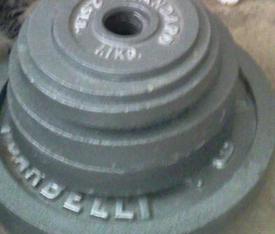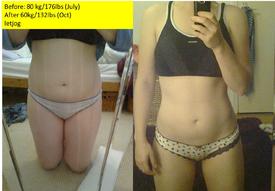Deep Squats "*kitten* to the grass"
Replies
-
Your form may have been off. While they look straightforward, Squats are a rather technical exercise and a fair amount of learning and practice must be established before going heavy.
My sentiments almost exactly.
It's very technical, but once mastered, it's like driving. You don't think about all the technical **** you're doing.
I found stretching in between sets to be very helpful to me in building strength and overall flexibility in my bottom half. The more flexible you become, the better you can drop that @ss.0 -
bump0
-
it's vitally important that your knees don't go further forward than your toes.
No, it's not. It depends on anatomy. Some people's knees will go past their toes. I don't know why people keep perpetuating this.0 -
I used to feel it before someone told me to push with my heels. They also told me to stop wearing running shoes and squat in my socks, a pair of Chuck Taylors or Five Fingers. No knee pain since then!
I'm reading Starting Strength too and it is a lot of info but very valuable! Interesting enough, chapter two is on Squats!0 -
hmm thanks for your input guys!
 i guess my form was wrong. i will see if i can get one othe trainers at the y to check out my squat form. :flowerforyou: 0
i guess my form was wrong. i will see if i can get one othe trainers at the y to check out my squat form. :flowerforyou: 0 -
I'm suspecting a muscle imbalance my be an issue. If you have stronger quads than hamstrings it could cause problems. I would try hamstring strengthening accessory lifts, or the other way around if you have strong hamstrings and weak quads.
I wouldn't worry too much about knee tracking over the toes, I think that thought is geared more for lunges.
wow, I never knew this. I always thought your menisci would be harmed by not slipping back in to place quickly enough when standing from the squat if your knees were not tracking over your toes. Interesting. 0
0 -
it's vitally important that your knees don't go further forward than your toes.
No, it's not. It depends on anatomy. Some people's knees will go past their toes. I don't know why people keep perpetuating this.
Bah, you beat me to it.
This is yet another one of those 'squatting myths' that refuse to die. I have actually found that foot angle can play a bigger role in knee pain that anything else, and everyone is different. Some people's feet need to be pointed more forward, some more outward, some right in line with the bend of the knee.
As it's been stated, the squat, especially when performed deep, is easily the most complex fundamental lift, and the easiest to do in a manner that will hurt like hell. You may have to play with it quite a bit to find your sweet spots.0 -
it's vitally important that your knees don't go further forward than your toes.
No, it's not. It depends on anatomy. Some people's knees will go past their toes. I don't know why people keep perpetuating this.
Bah, you beat me to it.
This is yet another one of those 'squatting myths' that refuse to die. I have actually found that foot angle can play a bigger role in knee pain that anything else, and everyone is different. Some people's feet need to be pointed more forward, some more outward, some right in line with the bend of the knee.
As it's been stated, the squat, especially when performed deep, is easily the most complex fundamental lift, and the easiest to do in a manner that will hurt like hell. You may have to play with it quite a bit to find your sweet spots.
Why? Just trying to understand. Not enough flexibilty or mobility to sit in a squat without lifting the heels? Flexion and extension at the ankle takes place at the talocrural joint, and as in all joints those movements are limited by muscular tension,ligaments and bone.Isn't it the tension in the soleus and gastrocnemius muscles on the back of the leg that prevents someone from pressing the heels to the ground in flexion? I don't know, I've just always thought the "fix" for that incapacity is just sitting in a squat with your your heels touching the ground in a wide stance and toes angled out till you can bring your feet close together and parallel.0 -
I said role in knee pain. I didn't say anything about foot angle directly affecting depth. Turn your feet a few degrees in or out when squatting, and tell me you can't feel a pressure difference in your knees. Using myself as an example, I have weird *kitten* feet that point outward, even when walking. I tried doing that whole 'keep your feet in line with the direction your knees bend' thing when squatting, and all it did was make my knees hurt like hell. Once I let them point back outward in their naturally goofy positioning, all knee pain went away. Some people seem to have the opposite issue, where they need to point their feet more toward the front than to the sides.0
-
It may have been a form issue. Actually a lot of things I read that if you go past the 90 degree point you actually have LESS strain on the knees. I also have "bad knees" and squats have done tons for improving my health of them and buildup of accessory muscles surrounding them
 0
0 -
it's vitally important that your knees don't go further forward than your toes.
No, it's not. It depends on anatomy. Some people's knees will go past their toes. I don't know why people keep perpetuating this.
it's what I've always read and been told pretty much everywhere (and I've read up on technique etc carefully, and from personal experience, i.e. my knees hurt if they go forward past my toes... if it's not true (for everyone) then that's news to me. Not arguing with you or saying you're wrong, just "I don't know why people keep perpetuating it" - because they believe it to be correct...? If it's wrong then there's a lot of books and websites and you tube videos that need to be corrected.0 -
it's vitally important that your knees don't go further forward than your toes.
No, it's not. It depends on anatomy. Some people's knees will go past their toes. I don't know why people keep perpetuating this.
Bah, you beat me to it.
This is yet another one of those 'squatting myths' that refuse to die. I have actually found that foot angle can play a bigger role in knee pain that anything else, and everyone is different. Some people's feet need to be pointed more forward, some more outward, some right in line with the bend of the knee.
As it's been stated, the squat, especially when performed deep, is easily the most complex fundamental lift, and the easiest to do in a manner that will hurt like hell. You may have to play with it quite a bit to find your sweet spots.
thank you for the info/clarification0 -
I did. I had the exact same experience.
Here's what I did differently.
My knee was clicking and rubbing wrong, my kneecap all messed up and PAIN. This was the end of January / beginning of February. At first I thought I'd hurt it when I'd fallen and caused some serious problem. Then I thought - maybe Im doing squats wrong (going *kitten* to grass). Then I thought - maybe it was from running for 3 years.
I started taking a glucosomine / chondroitin supplement for joints.
I quit doing to *kitten* to grass squats as well and go just slightly below parallel.
I started paying more attention to my form in general and had someone reshow me to see if Id taught myself wrong.
My knee issues are now about a third of what they were a month ago.
But I do not think it is instant and because of glucosomine.
I also do not think it was instant because of no longer going so low either - I just think I need to work up to that.
Here is what I think did the trick.
I always skipped warm ups.
I would get to the gym, see the squat rack open, run straight to it like it was the last hot meal on earth and jump straight in.
COLD.
Cold muscles.
Cold hard unlubricated joints.
I would go in with about 12-15 warm up reps at a weight that was obviously too low to matter, so hoenstly, that didn't do much for me.
Now I attack my warm up like it's the real actual first course of my workout meal. I started to do bodyweight squats, at least 30 - yesterday I got up to 60. I do jumping jacks, lunges - i hate doing leg swings because of an old hip injury, but I make sure that my knees are hot and lubricated and so are my hips and back.
I dont care about getting my heart rate elevated so I can burn more calories. I DO care about warming up the machine so I can handle business. (Just like when you warm up your car in states that come with wintertime.)
A cold biological machine will never do it's best work.0 -
Done right.
 0
0 -
Yeah, it's shocking to me how many people neglect warmup sets and mobility work.0
-
Yeah, it's shocking to me how many people neglect warmup sets and mobility work.
Not timbah.0 -
This content has been removed.
-
Yes. Warm up and stretch. My routine is at least 20 minutes and then when I get into the rack, I squat with no weight, then I squat with the bar. Then I do these weird stretches I do for hip mobility, then I add 10 lbs to the bar, squat, then I add ten more, and squat, then it starts getting heavy.
This warm up and stretch routine is critical and has completely changed my success with squats.
ALL OF THIS.
I start with bodyweight squats in my warmup, then I get the bar, add ten, add twenty, add thirty then go into my actual lifting routine. Since starting to warm up I have had much much much better results with my knee and Ive also started making good gains again.
I recently jumped up 25# after spending a week ONLY using the bar and concentrating on warmups.
OH ALSOOOOOOOOOO
AND THIS IS BIG, I TOTALLY FORGOT
I have been using a foam roller either after my leg workouts or after my workout the next day. I spend a timed 10-15 minutes on my legs alone. I pay extra special attention to my inner and outer legs. If the connective tissues and the muscle casing, etc are not cared for, they can pull and twist in ugly ways that will pull and twist on your knee joints. I read somewhere that knees are dumb joints because they rely so much on surrounding joints to get anything done. Therefore they need help in the area between them and the next joints. I dont know how much faith I put in that part, but I do know about the dangers of being in any kind of strenuous exercise program and not warming up or taking care of soft tissue work.
You cut out two major chunks of the work (warm up/cool down and muscle care) and you'll most likely end up with a ripe juicy injury. (Or a cold, hard, brittle one)
:flowerforyou:0 -
Done right.

Ouch, that looks painful. What's with the feet pointing inwards, relative to the leg? That would hurt the hell out of me.0 -
Not inward, straight!0
-
I did Brazil Butt LIft for knee pain when running after being in Physical Therapy for patella tendonitis. When I read on MFP about "*kitten* to grass" it took my squats and lunges to a whole new level. I love the BBL program and with the extra help to know I need to get deeper into my squat, it's made a world of diffrence for me. I do also do Tai Cheng and the Combat program to work on hip flexibility and hip strength, flexibility is so key IMO.0
-
I have seriously trashed knees. The medical diagnosis is Chondromalasia Patellae. I have a bad Q-angle and my kneecaps do not track properly, which results in bones spurs and blood buildup behind my kneecaps. Excruciating pain behind the kneecaps. The right one is the worst and I ended up having surgery on it 13 yrs ago where they cleaned up the back of the kneecap and removed the ligament that was connected to the outside of the kneecap so it wouldn't pull so hard to the right. Surgery helped a lot, after a lot of rehab to train another muscle to do the work that the former muscle was doing, but I still cannot squat down, or climb stairs. I have to always lead with my left leg when climbing stairs. Both knees sound horrible, you can hear the grinding sound from feet away.
But at least I can walk again.
Before my knee injury I was squatting heavy, walking lunges with 125 on my shoulders, and pressing 360 on the leg press machine. I also had a job that required a lot of stair climbing and squatting. Not sure exactly what did the damage to my knees, but probably a combination of it all, and my habit of pushing thru pain and not complaining.
I recently started using some straps that you hang over a door to do some upper body work. They don't stretch, you just use your body weight to do pushups and rows.
I had read about full squats recently, but in the 90s when I was lifting, the hard rule was to NEVER drop below 90 degrees.
But I had an idea, and I took the straps in hand, leaned back and did a full squat down and up. ZERO pain in my knees! I did 10 in a row without any pain at all. I stopped there to make sure I didn't get any delayed pain, and by the next day I still had to pain from the squats.
I have been doing 2 sets of 10 squats every other day and I am starting to see a difference in my pain levels. I know that the straps are taking some of my body weight off of my knees, so I don't know if I will be able to progress to full body weight and even added weight, but for now I am just thrilled that I can do the squats.
I would never have believed it if I hadn't seen it for myself.0 -
No I don't think I have ever had a problem. When I was competing in powerlifting, we had to go butt below the knees for our squat to count, so I did them quite often. Maybe try positioning your feet differently or different weight?0
-
I have seriously trashed knees. The medical diagnosis is Chondromalasia Patellae. I have a bad Q-angle and my kneecaps do not track properly, which results in bones spurs and blood buildup behind my kneecaps. Excruciating pain behind the kneecaps. The right one is the worst and I ended up having surgery on it 13 yrs ago where they cleaned up the back of the kneecap and removed the ligament that was connected to the outside of the kneecap so it wouldn't pull so hard to the right. Surgery helped a lot, after a lot of rehab to train another muscle to do the work that the former muscle was doing, but I still cannot squat down, or climb stairs. I have to always lead with my left leg when climbing stairs. Both knees sound horrible, you can hear the grinding sound from feet away.
But at least I can walk again.
Before my knee injury I was squatting heavy, walking lunges with 125 on my shoulders, and pressing 360 on the leg press machine. I also had a job that required a lot of stair climbing and squatting. Not sure exactly what did the damage to my knees, but probably a combination of it all, and my habit of pushing thru pain and not complaining.
I recently started using some straps that you hang over a door to do some upper body work. They don't stretch, you just use your body weight to do pushups and rows.
I had read about full squats recently, but in the 90s when I was lifting, the hard rule was to NEVER drop below 90 degrees.
But I had an idea, and I took the straps in hand, leaned back and did a full squat down and up. ZERO pain in my knees! I did 10 in a row without any pain at all. I stopped there to make sure I didn't get any delayed pain, and by the next day I still had to pain from the squats.
I have been doing 2 sets of 10 squats every other day and I am starting to see a difference in my pain levels. I know that the straps are taking some of my body weight off of my knees, so I don't know if I will be able to progress to full body weight and even added weight, but for now I am just thrilled that I can do the squats.
I would never have believed it if I hadn't seen it for myself.
That's awesome! Have you had any problems with excessive pronation?
Strengthening the vastus medialis obliquus can also help increase the stability of the knee joint in women. 0
0 -
I can't add much to the squat discussion, but I will say that glucosamine / chondroitin is a wonder. I tried it on the advice of my dad who was a runner for 30+ years. I was having knee pain while training for a half marathon. Within a few weeks, my knees felt back to normal. Good, good stuff.0
-
I have a deformity in the cartilage of my knees. ive had knee problems since childhood. ATG squats have really rehabbed my knees. The "stop at or before parallel" kind makes me nauseous. stopping 100+lbs using nothing but my knees and thighs is just horrible. ATG allows my knees to take a break from the pressure at the bottom.0
-
Amusingly, I was speaking with a physician today about glucosamine and chondroitin. Turns out all the research seems to indicate it does nothing at all. Placebo effect.0
-
Squates are bad for the knees if u do them incorrectly.
They are good for the knees if done correctly as they help strengthen the quad muscles (amongst others) which are knee stabilisers.0 -
Amusingly, I was speaking with a physician today about glucosamine and chondroitin. Turns out all the research seems to indicate it does nothing at all. Placebo effect.
Not ALL the research. A lot of the research. There's also evidence it can help. There's not enough evidence for the NHS to subscribe to it. But who are you to quash people's hopes?0 -
It's critical that your knees NOT go over your toes. You should be leaning backwards, with your weight on the bar. Do them in a squat rack, not free in the middle of the weight area. They can mess up your knees badly if your form is not correct.
My thoughts exactly ... A form issue. 0
0
This discussion has been closed.
Categories
- All Categories
- 1.4M Health, Wellness and Goals
- 398.4K Introduce Yourself
- 44.7K Getting Started
- 261K Health and Weight Loss
- 176.4K Food and Nutrition
- 47.7K Recipes
- 233K Fitness and Exercise
- 462 Sleep, Mindfulness and Overall Wellness
- 6.5K Goal: Maintaining Weight
- 8.7K Goal: Gaining Weight and Body Building
- 153.5K Motivation and Support
- 8.4K Challenges
- 1.4K Debate Club
- 96.5K Chit-Chat
- 2.6K Fun and Games
- 4.7K MyFitnessPal Information
- 17 News and Announcements
- 21 MyFitnessPal Academy
- 1.5K Feature Suggestions and Ideas
- 3.2K MyFitnessPal Tech Support Questions
















